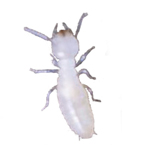Characteristics
Size : Worker: 1/8- to 3/8-inch in length.
Soldier : Body is similar to that of the worker, but large, deck head with powerful mandibles.
Supplementary Reproductive : About one inch in length.
Primary Reproductive : About one inch in length.
Color : Worker: Pale, cream colored.
Soldier : Light colored with brown head.
Supplementary Reproductive : Light colored.
Primary Reproductive : Dark brown/black.
Soldiers have an elongated head with pincer-like mandibles. Supplementary Reproductives have either no wings or very short non-functional wings, while Primary Reproductives have four wings of equal size until they are shed. Primary Reproductives are the termites most often seen in the open. They are commonly referred to as “swarmers.”
Behavior
This termite is known to swarm in spring, but small flights can occur at any time of the year. Swarming is the visible means that termites use to establish new colonies. As the colony grows, specialized castes are produced for the different tasks required. One caste produced is the workers. Another caste is the soldiers. And a third caste is the reproductives. Primary reproductives swarm and start new colonies. They are called alates or swarmers. Although thousands of primary reproductives may be produced each year, they all leave the nest. Supplementary reproductives, on the other hand, can become reproductive only in the colonies in which they were born. They assist the primary king and queen in population growth of the colony.
Habitat
Subterranean termites live in colonies in the ground, building vertical tunnels that look like mud tubes above ground level so that they can search for food. Because subterranean termites will die if exposed to air for an extended period of time, the tunnels provide protection from the open air, allowing workers to carry food to the nest. Subterranean termites can form tunnels through cracks in concrete, so slab homes are not exempt from these termites. They need to stay in contact with the soil in order to survive, unlike drywood termites that only need low moisture.



